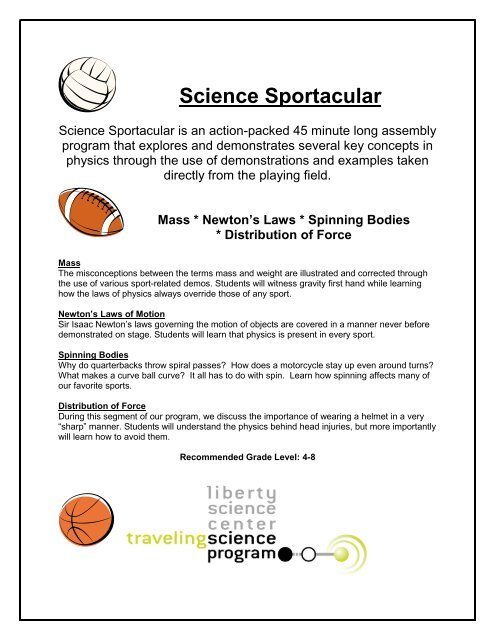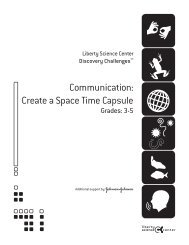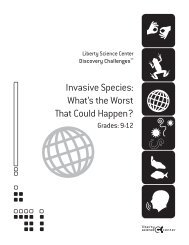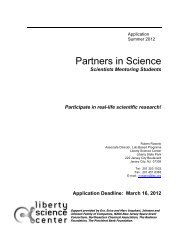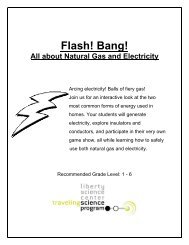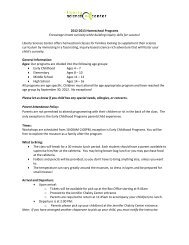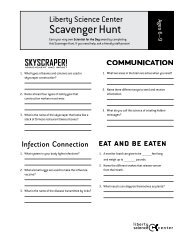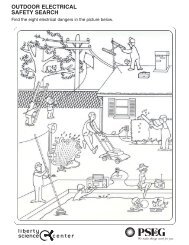Science Sportacular - Liberty Science Center
Science Sportacular - Liberty Science Center
Science Sportacular - Liberty Science Center
You also want an ePaper? Increase the reach of your titles
YUMPU automatically turns print PDFs into web optimized ePapers that Google loves.
<strong>Science</strong> <strong>Sportacular</strong><br />
<strong>Science</strong> <strong>Sportacular</strong> is an action-packed 45 minute long assembly<br />
program that explores and demonstrates several key concepts in<br />
physics through the use of demonstrations and examples taken<br />
directly from the playing field.<br />
Mass * Newton’s Laws * Spinning Bodies<br />
* Distribution of Force<br />
Mass<br />
The misconceptions between the terms mass and weight are illustrated and corrected through<br />
the use of various sport-related demos. Students will witness gravity first hand while learning<br />
how the laws of physics always override those of any sport.<br />
Newton’s Laws of Motion<br />
Sir Isaac Newton’s laws governing the motion of objects are covered in a manner never before<br />
demonstrated on stage. Students will learn that physics is present in every sport.<br />
Spinning Bodies<br />
Why do quarterbacks throw spiral passes? How does a motorcycle stay up even around turns?<br />
What makes a curve ball curve? It all has to do with spin. Learn how spinning affects many of<br />
our favorite sports.<br />
Distribution of Force<br />
During this segment of our program, we discuss the importance of wearing a helmet in a very<br />
“sharp” manner. Students will understand the physics behind head injuries, but more importantly<br />
will learn how to avoid them.<br />
Recommended Grade Level: 4-8
<strong>Science</strong> <strong>Sportacular</strong><br />
Program Information<br />
NJ Standards:<br />
NJCCCS 2009:<br />
Standard 5.1.8.A Understand Scientific Explanations<br />
Standard 5.1.4.B Generate Scientific Evidence through Active Investigation<br />
Standard 5.1.8.B Generate Scientific Evidence through Active Investigation<br />
Standard 5.1.4.D Participate Productively in <strong>Science</strong><br />
Standard 5.1.8.D Participate productively in <strong>Science</strong><br />
Standard 5.2.4.E Forces and Motion<br />
Standard 5.2.6.E Forces and Motion<br />
Standard 5.2.8.E Forces and Motion<br />
Standard 5.4.4.A Objects in the Universe<br />
Learning Objectives:<br />
By the end of the presentation, the audience will know and be able to develop an<br />
understanding that:<br />
Gravity pulls objects toward the earth at the same rate regardless of their mass<br />
Newton’s First Law states that objects in motion or at rest will remain that way<br />
unless acted upon by an outside force<br />
Newton’s Second Law states that the force exerted on an object is equal to its mass<br />
times the acceleration of the object<br />
Newton’s Third Law states that for every action there is an equal and opposite<br />
reaction<br />
Angular momentum keeps objects spinning in a certain plane<br />
Safety equipment protects us by distributing force over a greater area<br />
Program Overview:<br />
The laws of physics describe how objects behave when they are in motion. Sports<br />
involve the motion of people and equipment, both of which adhere to these laws. This<br />
program demonstrates gravity, Newton’s Laws of Motion, angular momentum, and<br />
distribution of force. All topics are explained and demonstrated using actual sport<br />
equipment and many volunteers.<br />
Special Instructions:<br />
*See Equipment requirements next page
Thank you for reserving … <strong>Science</strong> <strong>Sportacular</strong><br />
There are just a few things we will need:<br />
1. Parking:<br />
Safe, legal parking with easy access to our vehicle must be provided.<br />
2. Space:<br />
If booked as an assembly, our program requires large indoor space such as an<br />
auditorium or gymnasium. Please be advised that this space must be available to<br />
us 45 minutes prior to the scheduled start time for set-up and 30 minutes following<br />
the conclusion for breakdown.<br />
(For safety reasons, we cannot have students in the area while we are engaged in the setup<br />
or breakdown of programs.)<br />
3. Equipment<br />
We bring everything, EXCEPT... One large table provided by you (minimum<br />
size two feet wide x six feet long)<br />
(Please have the table set up prior to our arrival so we may begin our set-up promptly.)<br />
We will need access to one normal (grounded) 110-volt electrical outlet.<br />
(Please be sure outlets in the performance area are working and unobstructed.)<br />
4. Restrictions<br />
The audience size is limited to a maximum of 300.<br />
5. Directions<br />
If you know that the online driving directions to your location are inaccurate,<br />
please see the next page.<br />
Please contact us at 201.253.1310<br />
if any of these outlined criteria present an issue.
Our Traveling <strong>Science</strong> Educators normally use MapQuest for directions. Most times the<br />
directions are accurate. However:<br />
If directions from online services to your venue are inaccurate or difficult to understand,<br />
please use this form to clearly print or type directions to your location.<br />
If there are any special instructions we must follow once we get to your location, please<br />
note them below.<br />
Please use this form only. Do not substitute!<br />
Venue (program site):<br />
Date of program:<br />
Contact name:<br />
Telephone:<br />
Estimated driving time from <strong>Liberty</strong> <strong>Science</strong> <strong>Center</strong>: _____ Hours _____ Minutes<br />
To ensure our timely arrival, we MUST know how long it takes to reach you.<br />
Directions (Must start from Exit 14B of the N.J. Turnpike or the Holland Tunnel):<br />
Please return via mail:<br />
Or by fax:<br />
<strong>Liberty</strong> <strong>Science</strong> <strong>Center</strong><br />
Traveling <strong>Science</strong> Program<br />
222 Jersey City Boulevard<br />
Jersey City, NJ 07305-4699<br />
201.434.6100 Attn: Traveling <strong>Science</strong> Program<br />
In case of inclement weather, call 201.253.1280 as early as possible. Please<br />
reschedule for the next working day at 201.253.1310.<br />
Please return this form no later than two weeks prior to our visit.
<strong>Science</strong> <strong>Sportacular</strong> Assembly Program<br />
Pre-Visit Activity Guide<br />
This packet contains some simple classroom activities utilizing everyday,<br />
inexpensive (or even free!) items. Please feel free to duplicate these pages as<br />
needed - they are sent on plain white paper to ensure the best quality of<br />
reproduction.<br />
We suggest that these activities be conducted before our visit in order to<br />
familiarize students with some of the concepts we will explore together during our<br />
<strong>Sportacular</strong> presentation. However, they may be performed after our visit to<br />
serve as a reinforcement of the concepts covered in the program. If and when<br />
you choose to use these activities, or whether or not the activities are appropriate<br />
for your class, is entirely at your discretion.<br />
If you have questions about any of the enclosed activity procedures, please<br />
contact our <strong>Science</strong> Educators Associate Director at 201.253.1472.
I. Activities Exploring Gravity and Weight<br />
<strong>Center</strong> of Gravity: Lean on Me<br />
Materials:<br />
Students of similar height<br />
Male and female students<br />
A wall<br />
All objects have a point where they are held in balance by the force of gravity. This<br />
balancing point is called the center of gravity because it is the place where the whole weight of<br />
the object seems to center.<br />
Activity #1<br />
Procedure:<br />
1. Pair students of similar heights.<br />
2. Have everyone point to where they think their center of gravity is.<br />
(*In most people standing up, their center of gravity is located about one (1) inch below the<br />
navel.)<br />
3. Have the students who are similar in height stand back to back shoulder to shoulder,<br />
and heel to heel.<br />
4. Next have the students bend over and attempt to touch their toes while keeping their<br />
backsides together.<br />
*This is an impossible task as the student’s center of gravity moves forward and makes their<br />
back to back stance unstable<br />
Activity #2<br />
*Only females will be able to accomplish this task since their center of gravity is just a little lower<br />
than that of males. When a male bends over in this stance, he places his center of gravity<br />
beyond his toes. A female maintains her center of gravity above her feet and can straighten up<br />
with little difficulty. This does not always work with young children.<br />
Continued…
Procedure:<br />
1. Choose two students, one male and one female.<br />
2. Have the students face a wall.<br />
3. Have students stand two (2) of their own foot lengths away from one another.<br />
4. Have the students bend over (using their hands for support) and place their heads<br />
against the wall with their bodies bent at a 90-degree angle at the waist.<br />
5. Have both students place their hands on their knees to keep their legs straight and<br />
their hands from being used to push-off from the wall.<br />
6. Now have both students stand back up to an erect position without using their hands<br />
for support, bending their knees or moving their feet.
Gravity Getting You Down?<br />
Materials:<br />
Plastic cup<br />
Thin string<br />
Paper clips<br />
Small nail or thumbtack<br />
Paper<br />
Rubber band<br />
Assorted small objects (pencils, marbles, stones, grapes, etc.)<br />
Objects have weight because gravity pulls on them. The greater the pull of gravity on<br />
an object, the more it weighs. People do not feel their weight if there is no gravity pulling on<br />
them or if they are floating freely. When you bounce on a trampoline you feel weightless when<br />
you are up in the air, however the feeling will only last until you come down to earth again.<br />
The pull of the earth’s gravity is less as you go further out into space; therefore we would<br />
weigh less in space. Astronauts float about in their spacecraft because there is little gravity to<br />
pull them down.<br />
Mass and weight are proportional to each other. The more mass a person has, the<br />
more they will weigh. The greater the mass the greater the pull of gravity will be on that person.<br />
Procedure:<br />
1. Hammer the nail or press the thumbtack into a vertical surface.<br />
2. Loop the rubber band inside the paper clip and hang the paper clip from<br />
the nail or thumbtack<br />
3. Make 3 holes on the rim up the cup and thread the string through the top to make a<br />
handle. Tie the ends together and then tie them to the end of the rubber band.<br />
4. Make a scale for your balance, using a piece of paper fixed behind the rubber band.<br />
Mark how far the rubber band moves when an object is weighed<br />
Use this balance to compare the weight of small objects. How do their weights<br />
compare to their mass?
II. Activities Exploring Newton’s Laws<br />
Getting Things Moving<br />
Objects that are still do not want to move and objects that are moving do not want to stop.<br />
This tendency of something to stay still or keep moving is called inertia. (The word comes from<br />
the Latin word for “lazy.”) To make something start or stop moving you must overcome its<br />
inertia. Inertia can be overcome by pushing or pulling an object. These pushes and pulls are<br />
known as forces. The heavier something is, the more force it needs to start it or stop it from<br />
moving.<br />
Is it easier to start something by moving it quickly or slowly? Try this experiment to find out.<br />
Materials:<br />
Thread<br />
Two heavy books<br />
A board about a foot wide and a foot long<br />
Two empty sodas cans<br />
Procedure:<br />
1. Tie a length of thread around two heavy books.<br />
2. Rest a board across two empty cans and put the books on top.<br />
3. Gently pull the thread.<br />
4. Now keep the thread slack and give it a really hard tug.<br />
The books should start moving quite easily.<br />
This time the thread should break because the books have too much inertia<br />
to start moving quickly.
Friction Slows Things Down…<br />
One way of moving things is to slide them over another surface. Think about pulling a sled.<br />
Does it slide more easily on ice or on a concrete path? When two rough or uneven surfaces rub<br />
together an invisible force called friction holds them back and makes moving difficult. Moving is<br />
easier when there is little friction between two surfaces.<br />
Investigate Friction<br />
Smooth or even surfaces produce less friction. That is why it is easy to zoom down a shiny slide<br />
in the park.<br />
Materials:<br />
A smooth piece of wood or a flat desk<br />
A metal tray<br />
A matchbook<br />
A stone<br />
Piece of wood<br />
An eraser<br />
An ice cube<br />
Procedure:<br />
1. Arrange a selection of objects in a line along the edge of a smooth piece of wood or a<br />
desk.<br />
2. Slowly raise the piece of wood or the desk until the objects begin to move. Make a note<br />
of the objects that move first.<br />
3. Repeat the experiment using the metal tray.<br />
Do the objects move more easily… or less easily down the metal tray? Do you have to lift the<br />
metal tray higher than the wooden board/desk before the objects will move? Which surface has<br />
the lowest friction?<br />
How it works:<br />
Some of the objects move more easily than others because there is less friction between their<br />
outer surface and the surface of the board/desk or tray. Feel the objects that move easily. They<br />
should feel smooth, with no rough surfaces.<br />
Friction always makes it harder to move things but this can sometimes be very useful. For<br />
example, the friction between the soles of your shoes and the ground stops you from slipping<br />
when you walk, and the wheels of a car could not grip the road without friction.<br />
Can you think of any situations in which friction helps us play a sport?<br />
Here are some examples:<br />
• The studs on soccer shoes increase friction to stop the players slipping on the grass.<br />
• Friction allows the players to kick the ball. Without friction it would slide off their feet.
Newton’s Second Law: Smooth Sailing<br />
Acceleration is the rate of change in velocity. Velocity is the rate and direction with which<br />
an object travels. The gas pedal in a car is called the accelerator because by pressing on it we<br />
can change the velocity (how fast the car is going). There is a formula for acceleration:<br />
F=ma Force = mass x acceleration<br />
This formula shows us that objects with more mass need greater forces in order to accelerate.<br />
The following experiment will show how heavier objects need a greater force to move.<br />
Materials:<br />
2 empty plastic bottles, preferably small water bottles<br />
Hair dryer<br />
Jellybeans<br />
Long tub of water<br />
Procedure:<br />
1. Cut the plastic bottles into an L-shape so that there is a cup part with a sheet of plastic<br />
sticking up like a sail.<br />
2. In one place a few jellybeans, just to give it some weight. In the other place as many<br />
jellybeans it can hold without sinking.<br />
3. Place both “ boats” into a long tub full of water.<br />
4. Turn on the hairdryer (be careful not to drop it in the tub) and blow air on the boats,<br />
racing them across the tub<br />
You will see the boat with the least mass will have a greater acceleration. Its speed will<br />
change faster with less force.<br />
The formula F = ma only works if you are accelerating on a surface, like a car on a road<br />
or a runner on a track. If objects are dropped and freefall through the air, they will fall at the same<br />
rate (9.8 m/s) regardless of their mass. This is because of the force of gravity.
Newton’s Third Law: Off to a Good Start<br />
Newton’s Third Law states “for every action there is an equal and opposite reaction.”<br />
What does the 100 yard dash have to do with Newton’s third law? For this activity you will need<br />
just a few blocks of wood and a stopwatch.<br />
Materials:<br />
Procedure:<br />
Two students<br />
Stopwatch<br />
Pencil and paper<br />
2 blocks of wood (1 part of 2x4, 1flat piece)<br />
Wall or curb<br />
Space to run<br />
1. Set up a start line and a finish line, 10-20 yards apart<br />
2. Set up a “starting block” by leaning the flat piece of wood against a wall or curb and<br />
place the other block further from the wall.<br />
3. Have one student race from the start to finish line from a sprinter’s position off the<br />
blocks; the other student will time the run. Run 3 trials.<br />
4. Repeat the trials, this time from standing position.<br />
When Olympic runners line up at the starting line, their feet are usually perched on small<br />
ramps. These ramps are called starting blocks. When a race begins, the runner will push off on<br />
the starting block. At the same time, the block is pushing back on the runner’s foot with the<br />
same amount of force. This equal but opposite reaction is what allows a runner to have a fast<br />
start.<br />
The average time for the trials off the starting blocks should have been faster than the<br />
trials from the standing position.
III. Activities Exploring Distribution of Force<br />
Bed of Cups<br />
Materials:<br />
4’ x 4’ sheet of cardboard<br />
100 Dixie cups<br />
Procedure:<br />
1. Place enough cups top down on the floor to support the piece of cardboard, leaving<br />
roughly 5 inches in between the cups.<br />
2. Place the cardboard on the cups, and have a student lie on their back on the cardboard.<br />
(The cups should crumple).<br />
3. Next arrange the cups on the floor so they completely cover a 4’ x 4’ area, leaving no<br />
space between the cups.<br />
4. Again place the cardboard on the cups and have a student lie on the cardboard.<br />
In the first scenario, the cardboard could not support the student’s weight because the<br />
force was not evenly distributed- a few cups received most of the weight and most received<br />
very little. No cups were crushed in the second scenario because the weight was evenly<br />
distributed over all the cups.<br />
You can also demonstrate the distribution of force with a chicken’s egg.<br />
We normally perceive eggs as fragile objects, easily cracked and broken. So asking a<br />
student to crush an egg in their hand would seem like a simple task, correct?<br />
Material:<br />
Egg, uncooked<br />
Procedure:<br />
1. Have a student place the egg in the palm of their hand, have them wrap their fingers<br />
around the egg and squeeze as hard as they can. As long as their fingers are evenly<br />
distributed, it is almost impossible to crush the egg.<br />
2. Next ask them to hold the egg in their hand and place the tips of their fingers as close<br />
together as possible on the middle of the egg and squeeze.
IV. ActivitiesExploring Spinning Bodies<br />
The High Heat<br />
Each pitch in a professional pitcher’s arsenal uses a different type of spin. Even the<br />
fastball is spun to keep it accurate. When the spinning baseball travels through the air, areas<br />
of high and low pressure can be found on different sides of the ball. The high pressure will<br />
“push” the ball towards the low area. Breaking pitches like curveballs and screwballs are a<br />
great example of this. Try to throw a Styrofoam ball and see if you can make it in the majors!<br />
Materials:<br />
Procedure:<br />
Baseball sized Styrofoam balls<br />
Enough space to be able to throw the Styrofoam ball<br />
1. Fastball: Hold the ball between your thumb, fore, and middle fingers. When you throw<br />
the ball, let the ball slip off the ends of your fingers. This will usually result in backspin,<br />
allowing the ball to travel in an upward motion.<br />
2. Curveball: Using the same grip as a fastball, when you throw the ball, snap your wrist.<br />
This gives the ball a completely different spin from the fastball, sending the ball “down<br />
and away” from a right-handed pitcher to a right-handed batter.<br />
3. Screwball: The same pitch as the curveball, except that the snap of the wrist is in the<br />
opposite direction. The ball will move to the opposite side of the plate then the curve,<br />
“down and in” to a right handed-batter.<br />
When the ball spins, air moves over the surface of the ball. Depending on which way<br />
the ball is spun one side of the ball travels into the air (the bottom on a fastball) or along with the<br />
air (the top of a fastball). High pressure is created when the surface travels into the air and<br />
when the surface travels with the air, low pressure is created. That high pressure “pushes” the<br />
ball in the low pressure, making the fastball rise, and the curveball curve.<br />
The Exploratorium: www.exploratorium.org – Thrown for a Curve


